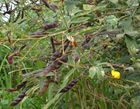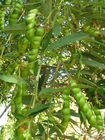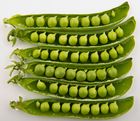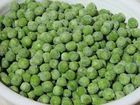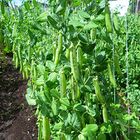Note: This is a project under development. The articles on this wiki are just being initiated and broadly incomplete. You can Help creating new pages.
Difference between revisions of "Cajanus cajan - Adhaki, Pegion pea"
(→External Links) |
(→References) |
||
| (32 intermediate revisions by 3 users not shown) | |||
| Line 1: | Line 1: | ||
[[File:Adhaki.jpg|thumb|right|''Cajanus cajan L'']] | [[File:Adhaki.jpg|thumb|right|''Cajanus cajan L'']] | ||
| − | + | The '''Cajanus cajan''' is a perennial legume from the Fabaceae family. Since its domestication in India at least 3,500 years ago, its seeds have become a common food in Asia, Africa, and Latin America. | |
| − | The | ||
| − | |||
==Uses== | ==Uses== | ||
| − | {{Uses|Jaundice | + | {{Uses|Jaundice}}, {{Uses|Stomachache}}, {{Uses|Diabetes}}, {{Uses|Purifying blood}}, {{Uses|Piles}}, {{Uses|Tongue sores}}, {{Uses|Gum inflammation}}, {{Uses|Spongy gums}}, {{Uses|Bedsores}}, {{Uses|Wounds}}, {{Uses|Malaria}}<ref name="Karnataka Medicinal Plants"/>. |
==Parts Used== | ==Parts Used== | ||
| − | {{Parts Used| | + | {{Parts Used|Seed}}, {{Parts Used|Leaf}}<ref name="Karnataka Medicinal Plants"/>. |
==Chemical Composition== | ==Chemical Composition== | ||
| − | Chemical constituent investigations have indicated that Cajanus cajan leaves are rich in flavonoids and stilbenes | + | Chemical constituent investigations have indicated that Cajanus cajan leaves are rich in flavonoids and stilbenes.<ref name="chemical composition"/> |
==Common names== | ==Common names== | ||
| − | {{Common names|kn=Togari, | + | {{Common names|kn=ತೊಗರಿ ಬೆಳೆ Togari bele, ತೊಗರಿ ಕಾಳು Togari kalu|ml=Thuvara, Tuvara|sa=Tuvari, Adhaki|ta=Tovarai, Thovary|te=Kandulu, Kadulu|hi=Arahad, Arahar|en=Pigeon Pea, Red Gram}}<ref name="Common names"/> |
==Habit== | ==Habit== | ||
| Line 20: | Line 18: | ||
==Identification== | ==Identification== | ||
===Leaf=== | ===Leaf=== | ||
| − | {{Leaf|Simple| | + | {{Leaf|Simple|Trifoliolate,lanceolate|Leafs are 2.5-13.5 cm long to 1-5.5 cm wide. The leaflets are green above and a silvery grey-green beneath and are covered on their lower surfaces in small yellow glands}}.<ref name="Leaf"/> |
===Flower=== | ===Flower=== | ||
| − | {{Flower|Unisexual|14cm long| | + | {{Flower|Unisexual|14cm long|Yellow, papilionaceous|Typical of species belonging to the Leguminosae subfamily Papilionoideae. Flowering from August to November}} |
===Fruit=== | ===Fruit=== | ||
| − | {{Fruit| | + | {{Fruit|Straight or sickle|2-13 cm long x 0.5-1.5 cm|The seeds are 4-9 mm x 3-8 mm and can be white, brown, purplish, black or mottled.||Many seeds|Fruiting from August to December}} |
| − | |||
| − | |seeds | ||
===Other features=== | ===Other features=== | ||
| Line 37: | Line 33: | ||
==Where to get the saplings== | ==Where to get the saplings== | ||
==Mode of Propagation== | ==Mode of Propagation== | ||
| − | {{Propagation|Seeds}}, {{Propagation| | + | {{Propagation|Seeds}}, {{Propagation|Cuttung}}. |
==How to plant/cultivate== | ==How to plant/cultivate== | ||
| − | Seed germinate in about 2 weeks | + | Seed germinate in about 2 weeks.<ref name="How to plant/cultivate"/> |
==Commonly seen growing in areas== | ==Commonly seen growing in areas== | ||
| − | {{Commonly seen|Semi-arid tropics}}, {{Commonly seen|Humid areas}}, {{Commonly seen| | + | {{Commonly seen|Semi-arid tropics}}, {{Commonly seen|Humid areas}}, {{Commonly seen|Cold-free zones}}. |
==Photo Gallery== | ==Photo Gallery== | ||
<gallery class="left" caption="" widths="140px" heights="140px"> | <gallery class="left" caption="" widths="140px" heights="140px"> | ||
| − | File:Cajanus cajan.jpg | + | File:Cajanus cajan.jpg|Whole tree |
| − | File:Cajan2.jpg | + | File:Cajan2.jpg|Nuts |
| − | File:Cajan3.jpg | + | File:Cajan3.jpg|Fruit |
| − | File:Cajan4.jpg | + | File:Cajan4.jpg|Seeds |
| − | File:Cajan5.JPG | + | File:Cajan5.JPG|At feild |
</gallery> | </gallery> | ||
==References== | ==References== | ||
| + | <references> | ||
| + | <ref name="chemical composition">[http://gbpihedenvis.nic.in/PDFs/Glossary_Medicinal_Plants_Springer.pdf Chemical composition]</ref> | ||
| + | <ref name="Leaf">[http://powo.science.kew.org/taxon/urn:lsid:ipni.org:names:1152177-2 Kewscience]</ref> | ||
| − | + | <ref name="Common names">[https://sites.google.com/site/indiannamesofplants/via-species/c/cajanus-cajan Common names]</ref> | |
| − | <ref name=" | + | |
| − | + | <ref name="How to plant/cultivate">[https://www.hort.purdue.edu/newcrop/duke_energy/Cajanus_cajun.html Purdue university]</ref> | |
| − | <ref name="How to plant/cultivate">[https://www.hort.purdue.edu/newcrop/duke_energy/Cajanus_cajun.html " | + | |
| + | <ref name="Karnataka Medicinal Plants">”Karnataka Medicinal Plants Volume-3” by Dr.M. R. Gurudeva, Page No.545, Published by Divyachandra Prakashana, #6/7, Kaalika Soudha, Balepete cross, Bengaluru</ref> | ||
</references> | </references> | ||
==External Links== | ==External Links== | ||
| + | * [http://agropedia.iitk.ac.in/content/diseases-pigeon-pea Pigeon pea on Agropedia] | ||
| + | * [https://plantvillage.org/topics/pigeon-pea/infos Pigeon pea on PlantVillage] | ||
| + | * [https://www.hort.purdue.edu/newcrop/duke_energy/Cajanus_cajun.html Cajanus cajun - purdue.edu] | ||
| + | * [https://www.feedipedia.org/node/22444 Cajanus cajun on Feedipedia] | ||
| − | + | [[Category:Herbs]] | |
| − | + | [[Category:Fabaceae]] | |
| − | |||
| − | |||
| − | |||
Latest revision as of 17:54, 11 January 2022
The Cajanus cajan is a perennial legume from the Fabaceae family. Since its domestication in India at least 3,500 years ago, its seeds have become a common food in Asia, Africa, and Latin America.
Contents
Uses
Jaundice, Stomachache, Diabetes, Purifying blood, Piles, Tongue sores, Gum inflammation, Spongy gums, Bedsores, Wounds, Malaria[1].
Parts Used
Chemical Composition
Chemical constituent investigations have indicated that Cajanus cajan leaves are rich in flavonoids and stilbenes.[2]
Common names
| Language | Common name |
|---|---|
| Kannada | ತೊಗರಿ ಬೆಳೆ Togari bele, ತೊಗರಿ ಕಾಳು Togari kalu |
| Hindi | Arahad, Arahar |
| Malayalam | Thuvara, Tuvara |
| Tamil | Tovarai, Thovary |
| Telugu | Kandulu, Kadulu |
| Marathi | NA |
| Gujarathi | NA |
| Punjabi | NA |
| Kashmiri | NA |
| Sanskrit | Tuvari, Adhaki |
| English | Pigeon Pea, Red Gram |
Habit
Identification
Leaf
| Kind | Shape | Feature |
|---|---|---|
| Simple | Trifoliolate,lanceolate | Leafs are 2.5-13.5 cm long to 1-5.5 cm wide. The leaflets are green above and a silvery grey-green beneath and are covered on their lower surfaces in small yellow glands |
.[4]
Flower
| Type | Size | Color and composition | Stamen | More information |
|---|---|---|---|---|
| Unisexual | 14cm long | Yellow, papilionaceous | Typical of species belonging to the Leguminosae subfamily Papilionoideae. Flowering from August to November | {{{5}}} |
Fruit
| Type | Size | Mass | Appearance | Seeds | More information |
|---|---|---|---|---|---|
| Straight or sickle | 2-13 cm long x 0.5-1.5 cm | The seeds are 4-9 mm x 3-8 mm and can be white, brown, purplish, black or mottled. | Many seeds | Fruiting from August to December |
Other features
List of Ayurvedic medicine in which the herb is used
- Vishatinduka Taila as root juice extract
Where to get the saplings
Mode of Propagation
How to plant/cultivate
Seed germinate in about 2 weeks.[5]
Commonly seen growing in areas
Semi-arid tropics, Humid areas, Cold-free zones.
Photo Gallery
References
- ↑ 1.0 1.1 ”Karnataka Medicinal Plants Volume-3” by Dr.M. R. Gurudeva, Page No.545, Published by Divyachandra Prakashana, #6/7, Kaalika Soudha, Balepete cross, Bengaluru
- ↑ Chemical composition
- ↑ Common names
- ↑ Kewscience
- ↑ Purdue university
External Links
Categories:
- Ayurvedic Herbs known to be helpful to treat Jaundice
- Ayurvedic Herbs known to be helpful to treat Stomachache
- Ayurvedic Herbs known to be helpful to treat Diabetes
- Ayurvedic Herbs known to be helpful to treat Purifying blood
- Ayurvedic Herbs known to be helpful to treat Piles
- Ayurvedic Herbs known to be helpful to treat Tongue sores
- Ayurvedic Herbs known to be helpful to treat Gum inflammation
- Ayurvedic Herbs known to be helpful to treat Spongy gums
- Ayurvedic Herbs known to be helpful to treat Bedsores
- Ayurvedic Herbs known to be helpful to treat Wounds
- Ayurvedic Herbs known to be helpful to treat Malaria
- Herbs with Seed used in medicine
- Herbs with Leaf used in medicine
- Herbs with common name in Kannada
- Herbs with common name in Hindi
- Herbs with common name in Malayalam
- Herbs with common name in Tamil
- Herbs with common name in Telugu
- Herbs with common name in Sanskrit
- Herbs with common name in English
- Habit - A small erect shrub
- Index of Plants which can be propagated by Seeds
- Index of Plants which can be propagated by Cuttung
- Herbs that are commonly seen in the region of Semi-arid tropics
- Herbs that are commonly seen in the region of Humid areas
- Herbs that are commonly seen in the region of Cold-free zones
- Herbs
- Fabaceae

